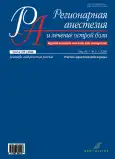Propofol and postoperative pain. Time to change priorities?
- Authors: Ovechkin A.M.1
-
Affiliations:
- I.M. Sechenov First Moscow State Medical University (Sechenov University)
- Issue: Vol 14, No 3 (2020)
- Pages: 118-120
- Section: Editorial
- URL: https://journals.rcsi.science/1993-6508/article/view/57658
- DOI: https://doi.org/10.17816/1993-6508-2020-14-3-118-120
- ID: 57658
Cite item
Abstract
Currently, the use of inhalational anesthetics is the basic method of general anesthesia. Propofol-based total intravenous anesthesia (TIVA) is not widely used. However, over the past years, evidence-based medicine data have been obtained on a decrease in the intensity of postoperative pain and the need for analgesics in patients operated on under the conditions of propofol-based TIVA, compared with inhalation anesthesia. It is possible that this fact will form the basis for revising general anesthesia regimens.
Keywords
Full Text
##article.viewOnOriginalSite##About the authors
A. M. Ovechkin
I.M. Sechenov First Moscow State Medical University (Sechenov University)
Author for correspondence.
Email: ovechkin_alexei@mail.ru
ORCID iD: 0000-0002-3453-8699
д. мед. н., профессор кафедры анестезиологии и реаниматологии
Russian Federation, MoscowReferences
- Chan A, Qiu Q, Choi S, Wong SS, Chan ACY, Irwin MG et al. Effects of intra-operative total intravenous anaesthesia with propofol versus inhalational anaesthesia with sevoflurane on post-operative pain in liver surgery: a retrospective case-control study. PLoS One. 2016;11(2): e0149753. DOI: https://doi.org/10.1371/journal.pone.0149753.
- Ogurlu M, Sari S, Kucuk M, Bakis M, Uguir B, Eshraghi YE et al. Comparison of the effect of propofol and sevoflurane anaesthesia on acute and chronic postoperative pain after hysterectomy. Anaesth Intensive Care. 2014;42(3):365–370. DOI: https://doi.org/10.1177/0310057X1404200314.
- Li M, Mei W, Wang P, Yu Y, Qian W, Zhang ZG et al. Propofol reduces early post-operative pain after gynecological laparoscopy. Acta Anaesthesiol Scand. 2012;56(3):368–375. DOI: https://doi.org/10.1111/j.1399-6576.2011.02603.x.
- Qiu Q, Choi S, Wong S, Irwin MG, Cheung CW Effects of intra-operative maintenance of general anaesthesia with propofol on postoperative pain outcomes: a systematic review and meta-analysis. Anaesthesia. 2016;71:1222–1233. DOI: https://doi.org/10.1111/anae.13578.
- Peng K, Liu H-Y, Wu S-R, Liu H, Zhang Z-C, Ji F-H. Does propofol anesthesia lead to less postoperative pain compared with inhalational anesthesia? A systematic review and meta-analysis. Anesth Analg. 2016;123(4):846–858. DOI: https:// doi.org/10.1213/ANE.0000000000001504.
- Song J, Shin J, Lee E, Choi DK, Bang JY, Chin JHC et al. Incidence of post-thoracotomy pain: a comparison between total intravenous anaesthesia and inhalation anaesthesia. Eur J Cardiothorac Surg. 2012;41(5):1078–1082. DOI: https://doi.org/10.1093/ejcts/ezr133.
- Zhang Y, Eger E, Dutton R, Sonner JM. Inhaled anesthetics have hyperalgesic effects at 0.1 minimum alveolar anesthetic concentration. Anesth Analg. 2000;91(2):462–466. DOI: https://doi.org/10.1097/00000539-200008000-00044.
- Rowley T, Daniel D, Flood P. The role of adrenergic and cholinergic transmission in volatile anesthetic-induced pain enhancement. Anesth Analg. 2005;100(4):991–995. DOI: https://doi.org/10.1213/01.ane.0000147708.73945.b3.
- O’Connor T, Abram S. Inhibition of nociception-induced spinal sensitization by anesthetic agents. Anesthesiology. 1995;82:259–266. DOI: https://doi.org/10.1097/00000542-199501000-00031.
- Bandschapp O, Filitz J, Ihmsen H, Berset A, Urwyler A, Kop-pert W et al. Analgesic and antihyperalgesic properties of propofol in a human pain model. Anesthesiology. 2010;113:421–428. DOI: https://doi.org/10.1097/ALN.0b013e3181e33ac8.
- Chen R, Chen T, Chen T, Lin L-L,Chang C-C, Chang H-C et al. Anti-inflammatory and antioxidative effects of propofol on lipopolysaccharide-activated macrophages. Ann N Y Acad Sci. 2005;1042: 262–271. DOI: https://doi.org/10.1196/annals.1338.030.
- Zhao M, Joo D. Enhancement of spinal N-methyl-D-aspartate receptor function by remifentanil action at delta-opioid receptors as a mechanism for acute opioid-induced hyperalgesia or tolerance. Anesthesiology. 2008;109:308–317. DOI: https://doi.org/10.1097/ALN.0b013e31817f4c5d.
- Kotani Y, Shimazawa M, Yoshimura S, Iwama T, Hara H. The experimental and clinical pharmacology of propofol, an anesthetic agent with neuroprotective properties. CNS Neurosci Ther. 2008;14:95–106. DOI: https://doi.org/10.1097/ALN.0b013e31817f4c5d.
- Singler B, Troster A, Manering N, Schuttler J, Koppert W. Modulation of remifentanil-induced postinfusion hyperalgesia by propofol. Anesth Analg. 2007;104(6):1397–1403. DOI: https://doi.org/10.1213/01.ane.0000261305.22324.f3.
- Pandit J, Andrade J, Bogod D, Hitchman J, Jonker W, Lucas N et al. 5th National Audit Project (NAP5) on accidental awareness during general anaesthesia: summary of main findings and risk factors. Br J Anaesth. 2014;113:549–559. DOI: https://doi.org/10.1093/bja/aeu313.
Supplementary files






